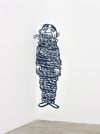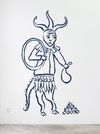Christian Andersen, Frederiksholms Kanal 28A, 1220 Copenhagen K, +45 2537 4101, info@christianandersen.net
Images
Press release
The body of work entitled, "Steven" derives from sources of honest emotion, inspired by the ordeals of the artist’s personal love life. Motivated to create works based on emotive content, Sven Loven looked towards images that he connected to and commiserated with. He was especially interested in the arcana of current mass media, as the constant mutation of duelling aesthetics in cyberspace provide novel manifestations of human expression. Many of the images derive from lowly sources, while some take inspiration from historic works of art and antiquated traditions. Loven was often drawn to content that he felt was truthful in emotion but unrefined in nature; an avatar from an video game; a trashy tattoo design popular on the website deviantart. Images that he could commiserate with while also scorning intellectual were most intriguing, as they provided a internal tension that gave them extended life and energy. The title of the show, Steven, is meant to refer to an alternate persona of the artist, as the name Sven is often changed to Steve by Americans unfamiliar with
foreign names. Thus he envisioned the show's content to be extrapolations on love and desire from the perspective of a colloquial version of himself.
The first painting, "Ideal lover", employs the motif of a primitive smartphone coupled with an acidic and smoldering rendering of a "Kappa", a monster from Japanese folklore. The result is a mythological take on the generic image of the dating-site selfie, the combination of archaic lore with contemporary social technology resulting in a compelling juxtaposition of form and content. An anthropomorphic insect intersecting a cell phone makes up the motif of the second painting of the series, entitled, "Spurned Suitor". Violently emerging from the screen of an old flip phone, a cartoon image of a dejected roach holds a meagre bouquet of flowers, spiral exclamations emerging from his head signifying defeat in his quest for love.
Third in the series is the painting entitled, "How can we monetize love", depicting a coterie of warring lovers and friends, each figure illustrating a different caricature of emotion. The words of the painting, written in an aerial view 3-dimensional style, spell out the phrase, "How can we monetize love." This statement, intended to be double in meaning, references the profiting of social media sites on the love lives of their users. "I never gave you my all because I never knew if I would get it back" is the fourth painting in the series and depicts an avenging angel of sorts, inspired by a character from the video game series Tekken. In the background is a phrase used in a lovers’ quarrel, repeated twice visually to produce a cacophonous effect. The last painting, "Wrote your name on a bullet," is a counterpoint to the male avatar and represents an ideal of feminine strength and fortitude. Central in the painting is a rendition of Marie d'Orleans' statue of Joan of Arc from the early 19th century, behind her the motif of a popular tattoo depicting butterflies emerging from a suicide. Overlaying the entire image is a histrionic text that reads "I wrote your name on a bullet so that everyone would know you were the last thing going through my mind." This absurdly poetic and pathetic phrase was styled to the point of near illegibility and finally painted in their present baroquely decorative form as flickering flames of light. The final element glowing in white is a detail of a Japanese ASCII illustration depicting two kittens united in love. Taken as a whole, the work symbolizes the anguish of unrequited desire and unfulfilled ideals.
Finally, interspersed with these highly finished paintings are images directly painted on the wall in a haphazard manner. This assortment of iconographic symbols also vastly spans time and place in origin, ranging from medieval woodcuts to postings from social media. Reinforcing the symbolic content of the show, they aim to create a ritualistic presence, establishing impermanent manifestations of uniquely crafted sigils and archaic avatars. In this body of work Loven was interested in solidifying emotional expression using content he connected with on an emotional level but also scorned in some sense on an intellectual one. Through this process he hoped to produce an honest and unironic reflection of both his emotional experiences as well as the current realm of cultural hyper-connectivity that many of us find ourselves in.














